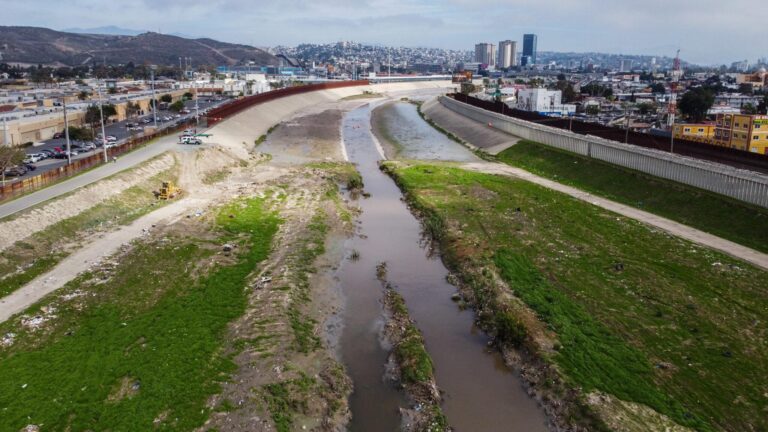Tijuana’s Border Sewage Dilemma and Its Repercussions for San Diego Communities
The ongoing issue of untreated sewage from Tijuana spilling into the Tijuana River continues to pose a serious environmental threat, with downstream effects felt acutely in San Diego’s coastal neighborhoods. This persistent contamination not only degrades beaches and recreational areas but also elevates public health risks, including respiratory ailments and gastrointestinal infections. Despite numerous alerts from environmental watchdogs, U.S. agencies have predominantly concentrated on symptom management—such as deploying temporary barriers and conducting beach cleanups—instead of tackling the fundamental problem: Tijuana’s overburdened and outdated wastewater treatment systems.
The disproportionate impact on San Diego residents underscores a complex transnational challenge, where neglect on one side of the border results in tangible consequences on the other. Community advocates and local leaders have urged for:
- Enhanced federal investment to modernize water treatment infrastructure in both countries
- Joint cross-border initiatives prioritizing prevention over reactive measures
- Improved transparency and accountability regarding pollution sources and mitigation efforts
As San Diego continues to develop its coastal economy and safeguard public health, experts warn that ignoring Tijuana’s sewage infrastructure deficiencies will only exacerbate the problem. Without robust binational collaboration, residents on both sides remain exposed to the ongoing environmental and health hazards posed by this unresolved sewage crisis.
| Area of Impact | Concerns in San Diego | Challenges in Tijuana |
|---|---|---|
| Public Health | Frequent beach closures, increased illness rates | Inadequate sewage treatment capacity |
| Environmental | Contaminated waterways and ecosystems | Deteriorating and insufficient infrastructure |
| Economic | Losses in tourism revenue | High costs for infrastructure upgrades |
Policy and Infrastructure Deficiencies Fueling Environmental Inequities Along the Border
Environmental disparities along the U.S.-Mexico border are intensified by systemic policy failures and infrastructure gaps. While Tijuana’s untreated sewage frequently contaminates San Diego’s waterways, U.S. authorities have often neglected to address their own infrastructure shortcomings. The lack of investment in comprehensive wastewater treatment and the absence of cohesive binational environmental agreements have left frontline communities—predominantly low-income and Latino populations—vulnerable to disproportionate pollution exposure and health risks. These inequities reflect not only uneven resource distribution but also political hesitancy to confront complex cross-border environmental issues.
Primary contributors to this environmental injustice include:
- Obsolete or insufficient wastewater infrastructure on the U.S. side near the border
- Disjointed regulatory systems that impede unified solutions
- Minimal involvement of affected communities in environmental policymaking
- Unequal enforcement of environmental laws influenced by geographic and demographic factors
| Policy Challenge | Resulting Impact | Communities Affected |
|---|---|---|
| Postponed infrastructure modernization | Recurring sewage discharges | San Diego border neighborhoods |
| Insufficient cross-border coordination | Ongoing pollution flow | Populations on both sides of the border |
| Gaps in environmental regulation | Unequal health hazards | Low-income and minority groups |
Tackling these intertwined issues demands a comprehensive strategy: increased U.S. funding for resilient border infrastructure, strengthened binational policy frameworks, and a dedicated emphasis on environmental justice to protect vulnerable populations from persistent pollution.
Health and Ecological Ramifications of Ongoing Sewage Contamination
The continuous influx of untreated sewage along the U.S.-Mexico border has escalated health risks for residents in both San Diego and Tijuana. Exposure to contaminated water has been associated with outbreaks of gastrointestinal diseases, skin conditions, and respiratory complications. Vulnerable groups, such as children and seniors, face amplified dangers due to prolonged contact with polluted environments and insufficient sanitation services. Healthcare providers in the region have documented an uptick in waterborne illnesses, highlighting the urgent need for collaborative binational interventions.
Beyond human health, the environmental toll is severe and long-lasting. Sewage discharge accelerates eutrophication in coastal waters, fostering harmful algal blooms that deplete oxygen and devastate marine life. This degradation threatens critical habitats, undermines biodiversity, and disrupts fisheries and tourism industries that local economies depend on. Key environmental concerns include:
- Declining water quality: Elevated concentrations of nutrients, pathogens, and hazardous substances.
- Marine ecosystem damage: Hypoxic zones causing fish kills and loss of native species.
- Soil contamination: Nutrient accumulation adversely affecting agricultural productivity.
- Cross-border complexity: Pollution transcends political boundaries, complicating cleanup efforts.
| Impact Category | Details | Immediate Consequence |
|---|---|---|
| Public Health | Increased incidence of gastrointestinal and respiratory diseases | Localized outbreaks |
| Marine Life | Oxygen depletion leading to fish mortality | Reduced fishery yields |
| Tourism | Unsafe water conditions and foul odors | Decline in visitor attendance |
| Agriculture | Polluted irrigation water sources | Lower crop production |
Recommendations for Binational Collaboration and Sustainable Remediation
Resolving this transboundary pollution crisis necessitates a holistic approach grounded in binational cooperation, empowering stakeholders from both Mexico and the United States to craft fair and enduring solutions. Joint investments in infrastructure can significantly reduce untreated sewage crossing the border while fostering mutual trust and shared accountability. Priority areas for action include:
- Modernizing wastewater treatment facilities on both sides to accommodate population growth and industrial discharge.
- Developing emergency response plans to swiftly address system failures or environmental disasters affecting water quality.
- Improving transparency and data exchange through shared monitoring networks and public reporting platforms.
Harmonized policymaking can align environmental standards, eliminate redundant efforts, and unlock access to international funding sources. The following table compares investment priorities for each side:
| Focus Area | Tijuana Priorities | U.S. Priorities |
|---|---|---|
| Infrastructure | Expand capacity and repair leaks | Upgrade and modernize treatment plants |
| Regulation | Enforce stricter industrial waste controls | Streamline cross-border environmental policies |
| Community Engagement | Launch public education campaigns | Host binational forums and stakeholder workshops |
Conclusion
As untreated sewage from Tijuana continues to flow into U.S. territory, the failure to address the underlying causes of pollution remains a critical concern. While downstream communities in San Diego suffer the environmental and health consequences, the absence of coordinated binational strategies underscores the complexity of managing shared water resources. Moving forward, meaningful progress hinges on transparent collaboration and substantial investments in infrastructure that safeguard public health and ecosystems on both sides of the border. Until such measures are implemented, the persistent odor and contamination serve as a stark reminder of the unresolved challenges lingering just beyond the border fence.







